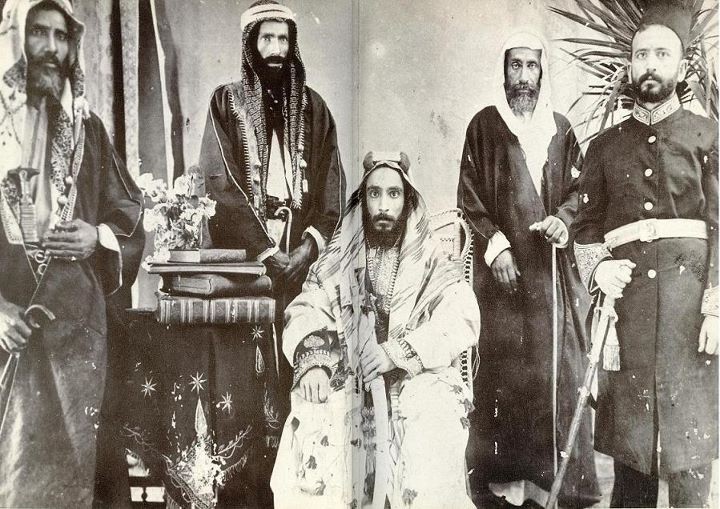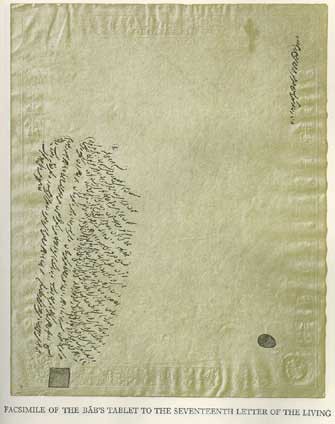
|
|
Abstract: Brief comparison of two opposing ideologies: fundamentalist Wahhabism vs. the less literalistic teachings of Shaykhism and the Bábí Faith. Notes: Mirrored from extranewsfeed.com. See many more articles by this author, most on topics relating to the Bahá'í Faith, science, and physics, at vahidhoustonranjbar.medium.com. |

Image of unidentified Saudi Scholars from 19th Century. (The second and fourth from left figures have in many articles been mistakenly identified as Muhammad ibn ʿAbd al-Wahhab, however as he passed away in 1792 before the invention of photography no photos could exist)
Muhammad ibn ʿAbd al-Wahhab and Shaykh Ahmad were born about 370 km apart near Riyadh and Al Hoff respectively, in present day Saudi Arabia. Muhammad ibn 'Abd al-Wahhab was born in 1703 and Shaykh Ahmad was born 50 years later in 1753. Both founded powerful new movements which purported to reform Islam, however their ultimate trajectories and fruits of their philosophy couldn't be more different.
Muhammad ibn ʿAbd al-Wahhab saw it as his mission to restore a more purer and original form of the faith of Islam. Thus, those who espouse his theology refer to themselves as Salafists after the as-salaf as-saliheen (the earliest converts to Islam) or Muwahhidun, meaning, "the monotheists." Towards this aim he proposed a more radical version of monotheism which condemned and waged war against the veneration for anything or person outside of the singular God. Thus the tombs of saints or the progeny of the prophet Muhammad were targets to be destroyed. Anyone who didn't adhere to this interpretation were considered polytheists worthy of death, including fellow Muslims (especially Shi'ite who venerate the family of Muhammad), Christians and others. He also advocated for a literalist interpretation of the Quran and its laws.
So for example some of his first actions on attaining authority with the ruler of the town of al-Uyayna was to destroy a sacred tomb revered by locals. He also ordered that an adulteress be stoned to death, thus reintroducing a practice which had fallen out of favor. These actions created enemies and he eventually had to flee al-Uyayna. However he ultimately found strong patronage with Muhammed Ibn Saud, a chief of desert raiders in Najd, Ibn Saud. Together they formed a pact which placed the chief as head of the political matters. Muhammad ibn ʿAbd al-Wahhab as head of theological matters, declared the rulers of Hijaz (holy Land of Arabia) to be non-Muslims due to their more tolerant practice of Islam and therefore worthy of attack and occupation. Thus the dynasty of the house of Saud eventually conquered most of the Arabian peninsula, and with the discovery of oil and the influx of wealth, projected this ideology around the world.

Shaykh Ahmad |
Shaykh Ahmad belonged to the Shi'ite sect of Islam, and as such venerated and adhered to the teachings handed down by the Shi'ite Imams. They believed that the first Imam appointed by Muhammad to succeed him was 'Alí, his cousin and son-in-law, and the first to be his disciple. Shi'ites regarded him as the Guardian of the Faith of Islám and its spiritual head. This appointment, however, was not in writing and there is no mention of it in the Qur'án. It was made verbally to a great number of his followers assembled at a place called the Pool of Khumm. As a result when the prophet passed away, the appointment of 'Alí was challenged by 'Umar, who later became the second Caliph of Islám. He campaigned against 'Alí, repudiating him and his position as the 'Interpreter of the Qur'án', purportedly saying: 'The Book of God is sufficient for us.' He effectively rallied the people instead around the old and venerable person of Abú-Bakr who was installed as the first Caliph. Thus outside of the Shi'ite sect, 'Alí's appointment was not considered conclusive or binding by the majority of the followers of Muhammad.
Shaykh Ahmad believed in the eminent fulfillment of the prophecies in the Qur'án. He also taught a non-literal symbolic interpretation of these prophecies. He saw it as his mission to prepare the world for the coming of the Al-Qa'im or Al-Mahdi and the return of Christ. Contrary to the Wahhabi view, he espoused an extreme veneration for the saints and Imams (decedents of the prophet Muhammad). Ultimately he also achieved much influence in present day Iran and the patronage of the ruling Persian Qajar dynasty.
He preached that the day judgement should be understood in a non-physical manner and that the rising of dead was in terms of their spirit. Sayyid Kázim Rashtí was appointed by him to succeed him and carried his teachings forward after Shaykh Ahmad's passing in 1826. Sayyid Kázim clarified many of Shaykh Ahmad's ideas. He also heightened Shaykh Ahmad's expectations of fulfillment, even devoting much time in describing the attributes of the coming promised one, delineating such details as his linage, age and comportment. Sayyid Kazim did not leave a successor, but before his death in December, 1843, he had counseled his followers to leave their homes to seek the Mahdi, who according to his prophecies would soon appear. Interestingly this expectation also corresponded with predictions of Christian millennialist movements which were sweeping across America and western Europe.
It was then in May 22 1844 that a relatively unknown merchant named Sayyid Ali Muhammad assumed the title of the Bab or Gate and claimed to be the promised one. Actually his first disciple Mullá Husayn, was one of the chief followers of Sayyid Kazim, who on the death of his leader, set out to search for the promised one. This declaration attracted a number of the more illustrious followers of the Shaykhi school, Including the famous poetess and female disciple Fatima Baraghani, named "Solace of the Eyes"("Qurat-ul-Ayn") by Sayyid Kazim.

Facsimile of the Bab's tablet written to Tahirh |
The Bab taught that he was preparing the way for another greater messenger of God who would usher in the establishment of the kingdom of God on earth. The Bab's piousness, intoxicating presence, and ability to reveal Arabic writings of profound beauty and depth without premeditation won over many. This despite the fact that he was not from the educated clerical class. This movement spread like fire throughout Persian society attracting converts from all classes of society. However opposition from the ecclesiastical and governmental authorities hardened especially after the famous incident in the Iranian town of Badasht. The early followers of the Bab had gathered together there to decided on how they could liberate their imprisoned leader the Bab. At this meeting was present Qurat-ul-Ayn. During a sermon she gave, she threw off her veil to shock and terror of the assembled men present and announced "I am the Word which the Qá'im is to utter, the Word which shall put to flight the chiefs and nobles of the earth!" This event was so shocking that a few of the believers renounced their faith and fled, another slit his own throat in terror at this sight. This act for Babis signalized the termination of old Islamic sharia law and the birth of a new divine law, which demanded equality for women. Interestingly this coincided with events on the other side of the planet, the first conference to address the emancipation of women was held in Seneca falls New York near the same time.
Later tales of this incident and the wanton immorality such an act implied, were used by the clerical establishment to excite the populace against the Babis. It was also at this conference where Qurat-ul-Ayn was given yet another new name, Tahirih (The pure one) by another prominent Babi and nobleman, Mírzá Ḥusayn-`Alí who would be known as Bahá'u'lláh (Glory of God). Bahá'u'lláh would years later in 1863 announce that he was the one foretold by the Bab. The overwhelming majority of Babis accepted Bahá'u'lláh and became known as Bahá'ís. In 1852 Tahirh would be executed via strangulation with a silk scarf and thrown into a well on orders of the Shah and clergy. Her last words were reported to have been "You can kill me as soon as you like. But you cannot stop the emancipation of women!"
Links to my other articles on religion and science:
-
Plato, Modern Physics and Bahá'u'lláh
One Physicist's first Look at Abdu'l-Bahá's Tablet of the Universe
The Known and Unknown: Physics and the Revelation of Bahá'u'lláh
Does the singularity of God require the singularity of Religion?
The Spirit of Faith and Eternal Life
A Talismanic View of Evolution
|
|